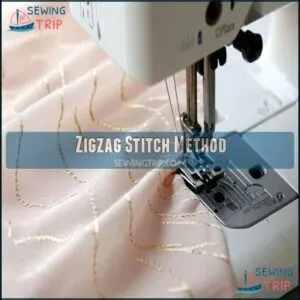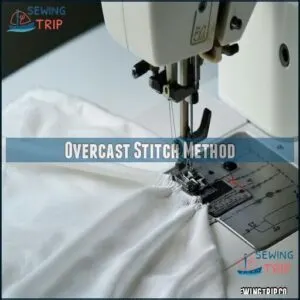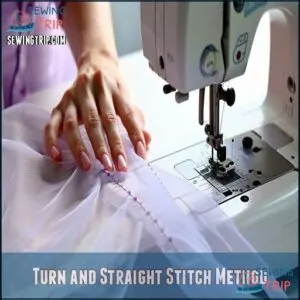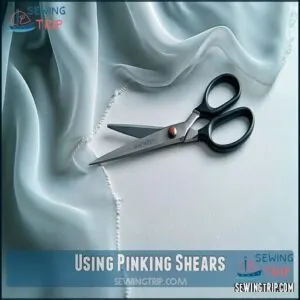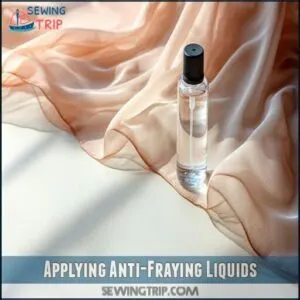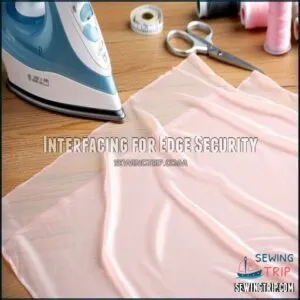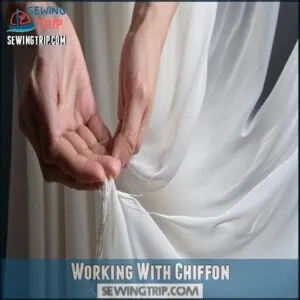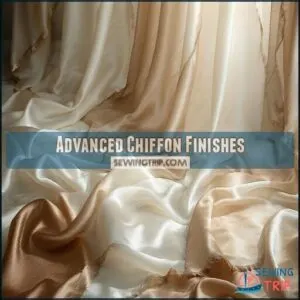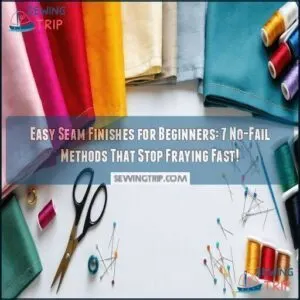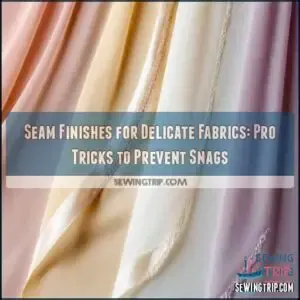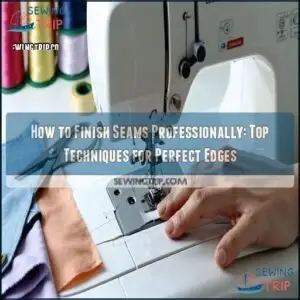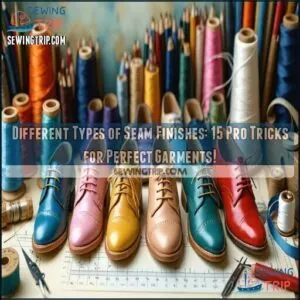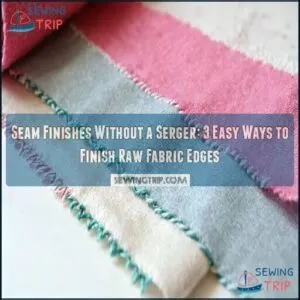This site is supported by our readers. We may earn a commission, at no cost to you, if you purchase through links.
 You’ll tame that slippery chiffon with these simple seam finishes that prevent fraying while maintaining the fabric’s delicate drape.
You’ll tame that slippery chiffon with these simple seam finishes that prevent fraying while maintaining the fabric’s delicate drape.
French seams work wonders by enclosing raw edges completely—perfect for translucent fabrics. Rolled hems using your sewing machine’s specialty foot create an elegant, nearly invisible finish.
For quick projects, try a narrow zigzag stitch close to the edge or apply a tiny amount of fray-check liquid. Pinking shears can help in a pinch, though they’re not a permanent solution for chiffon’s stubborn fraying tendencies.
These techniques aren’t just functional—they’ll elevate your garment from homemade to haute couture. They are simple yet effective methods to achieve a professional finish, making your garment look polished and well-made with delicate drape.
Table Of Contents
Key Takeaways
- French seams are your best option for chiffon as they completely enclose raw edges, creating a professional finish while maintaining the fabric’s delicate drape.
- You’ll prevent fraying with simple techniques like narrow zigzag stitches, pinking shears, or anti-fraying liquids—each offering different levels of protection depending on your project needs.
- When handling chiffon, you’ll need to use sharp fine needles (size 60-70), adjust to lighter tension settings (2-3), and consider using tissue paper or stabilizers to control the slippery fabric.
- You can match your seam finish to your project’s needs—French seams for translucent areas, bias tape for decorative edges, rolled hems for curved sections, and mock French seams for beginner-friendly alternatives.
Choosing Seam Finishes
You’ll need to match your seam finish to your chiffon fabric’s weight and sheerness to get professional results without frustration.
The right technique won’t just prevent fraying, but will also maintain your garment’s drape and comfort against the skin.
Embrace the perfect seam finish—where fabric preservation meets luxurious comfort and elegant drape.
French Seams for Chiffon
With chiffon, French seams are your best friend.
They elegantly encase raw edges inside a hidden pocket of fabric, preventing those pesky threads from fraying.
You’ll love how this technique enhances durability while creating professional aesthetics—perfect for lightweight fabrics like chiffon.
The clean finish provides elegant visuals both inside and out.
When sewing sheer fabrics, nothing beats the polished look of properly executed French seams, which offer a professional finish.
Hong Kong Seams for Sheer Fabrics
Why settle for ordinary finishes when Hong Kong seams offer a couture-level polish for your chiffon creations? This technique uses bias tape to wrap raw edges, creating an elegant finish that’s perfect for sheer fabrics.
- Bias tape selection affects both appearance and comfort against skin
- Reduces bulk while maintaining durability in delicate fabrics
- Creates clean finish seams visible on both sides of your garment
- Perfect for unlined chiffon where edges might be seen
- Requires careful sheer fabric handling but results are worth the effort, resulting in a clean finish that is both durable and elegant with delicate fabrics.
Mock French Seam Basics
Three simple steps make mock French seams your new best friend for chiffon. You’ll get the elegance of traditional French seams with half the hassle.
This beginner-friendly technique works beautifully on curves while preventing fraying in your delicate fabric seams. For the best results, use this technique to create a clean, professional finish.
| Feature | Mock French Seam | Traditional French Seam |
|---|---|---|
| Stitch visibility | Visible on right side | Hidden inside seam |
| Curve sewing | Easier, minimal clipping | Challenging on curves |
| Seam allowance | Standard (⅝") works fine | Requires wider allowance |
| Beginner projects | Excellent choice | More advanced technique |
The key benefits of using mock French seams include ease of use on curves, prevention of fraying, and a clean, professional finish. This makes them an excellent choice for beginner projects, offering a simpler alternative to traditional French seams.
Simple Finishing Techniques
You’ll find these simple finishing techniques perfect for taming chiffon’s notorious fraying edges without fancy equipment or years of sewing experience.
Tame chiffon’s wild edges with these simple techniques—no fancy equipment or years of experience needed.
With just your basic sewing machine and a bit of patience, you can create professional-looking seams that won’t unravel after the first wash, which is a great way to achieve perfect results.
Zigzag Stitch Method
The humble zigzag stitch is your best friend when tackling chiffon’s fraying tendencies.
Set your machine with a narrow stitch width (1.5-2mm) and shorter stitch length (2-2.5mm) for ideal results. You’ll want proper tension settings and a fine needle (size 70/10) to avoid damaging your fabric.
Discover more about adjusting stitch settings for different fabrics. Try placing tissue paper underneath while stitching to help stabilize chiffon during this beginner-friendly technique.
Overcast Stitch Method
The overcast stitch offers a reliable finishing method when working with delicate chiffon.
You can either hand overcast using a simple whipstitch around raw edges or use your machine’s overcast foot with appropriate tension settings.
For better fabric stability, try working in both directions to create a zigzag effect.
Using a specialized foot can simplify sewing.
This versatile technique prevents fraying in lightweight fabrics while maintaining the flowing drape that makes chiffon so appealing, and is a key part of delicate chiffon work.
Turn and Straight Stitch Method
The turn and straight stitch method offers one of the simplest yet effective ways to finish chiffon seams.
After sewing your seam allowance, you’ll:
- Fold the raw edge under by about 1/8 inch
- Press carefully with a cool iron to set the fold
- Use a short stitch length (2.0-2.5mm) for security
- Apply gentle pressure when sewing curved seams
This lightweight fabric seam technique prevents fraying while keeping your chiffon projects looking professionally finished.
For a more durable finish, consider a double stitched seam.
Preventing Fraying
You’ll save yourself hours of frustration by preventing your chiffon from fraying before it starts.
With the right techniques like pinking shears or anti-fraying liquids, you can keep those delicate edges intact through washing and wearing.
Using Pinking Shears
Despite their vintage look, pinking shears can be your chiffon’s best friend in the battle against fraying.
You’ll need quality shears with sharp blades for clean cuts. When snipping, hold the fabric taut and cut at a 45-degree angle for the best results.
While not a permanent solution for delicate chiffon, pinking creates tiny zigzags that slow unraveling until you can apply more secure finishes.
You can find various pinking shear options online, which can help with pinking.
Applying Anti-Fraying Liquids
In light of chiffon’s delicate nature, anti-fraying liquids offer a quick solution to seal those troublesome raw edges.
You’ll find these products create an invisible barrier that prevents unraveling without adding bulk to your seams.
- Apply a thin, even line along the edge using the bottle’s precision tip
- Allow 15-30 minutes of drying time before handling your fabric
- Test on scrap chiffon first as some brands may stiffen delicate fibers
- Choose clear formulas specifically designed for lightweight fabrics
Interfacing for Edge Security
Interfacing acts like a bodyguard for your chiffon’s delicate edges. You’ll want to apply lightweight fusible interfacing to secure those fraying-prone areas while maintaining drape.
For best results, remember to keep in mind the interfacing weight and type to match your fabric.
| Interfacing Type | Best For | Technique |
|---|---|---|
| Woven Interfacing | Straight edges | Press with dry iron first |
| Knit Interfacing | Curved seams | Use pressing cloth |
| Featherweight Fusible | Ultra-sheer chiffon | Lower temperature |
| Tear-away | Temporary reinforcement | Remove after stitching |
| Edge-specific | Necklines/armholes | Cut 1/4" smaller than seam |
When choosing an interfacing type, consider the specific needs of your project, such as using woven interfacing for straight edges or knit interfacing for curved seams, and always follow the recommended technique for the best outcome.
Working With Chiffon
You’ll find that chiffon slips through your fingers like water when you’re trying to sew it, but don’t worry—this troublemaker fabric can be tamed with the right techniques.
With proper finishing methods, you’ll transform those fraying edges into professional seams that look store-bought rather than homemade, using techniques that make the fabric look like it was made with professional care.
Handling Delicate Fabrics
Now that you’ve learned about preventing fraying, let’s look at how to handle chiffon’s delicate nature. Working with this slippery fabric requires patience and specific techniques to avoid damage during sewing.
- Use sharp, fine needles (size 60/8 or 70/10) specifically designed for lightweight fabrics
- Apply fabric stabilizers temporarily to prevent slippage while cutting and sewing
- Adjust machine tension to a lighter setting (usually 2-3) than normal
- Decrease stitch density to avoid creating perforations that weaken the fabric
- Place tissue paper underneath chiffon when cutting to prevent shifting
Pressing and Folding Techniques
With chiffon, proper pressing makes all the difference.
Always use a low heat setting and press gently to maintain fabric drape. Fold seam allowances carefully when creating French seams or rolled hems—steam helps tame those tricky curved seams without stretching.
Try layering effects by placing tissue paper between your iron and lightweight fabrics.
Remember, patience is key; pressing chiffon seam finishes isn’t a delicate dance but requires gentle handling.
Matching Seam Type With Fabric Weight
When working with delicate fabrics like chiffon, selecting the right seam type is essential for success.
You’ll want to match lightweight fabrics with French or narrow rolled seams to maintain their beautiful drape.
Heavier fabrics require sturdier finishes like flat-felled seams.
Remember that chiffon’s gossamer nature demands gentle handling—using a walking foot helps prevent puckering while ensuring your garment’s purpose isn’t compromised by bulky seams.
Advanced Chiffon Finishes
You’ll take your chiffon projects to the next level with these advanced finishing techniques that prevent even the stubbornest fraying.
Once you’ve mastered these methods, you’ll wonder how you ever managed without them, just like I did after ruining countless silk scarves before discovering these game-changers.
Bias Tape Finish for Chiffon
When your chiffon fabric threatens to fray at the edges, bias tape can be your saving grace.
Cut strips at a 45-degree angle to create your own tape that perfectly matches your delicate fabric.
For curved edge binding, this technique excels where others fail.
Simply attach the bias tape to raw edges, turn and press the seam, then topstitch for secure, professional-looking results.
Enclosing Raw Edges With Two Stitch Lines
While bias tape adds a decorative touch, the two-stitch line method offers simplicity for chiffon finishing.
You’ll need just your sewing machine and basic skills to master this technique.
First, sew a straight stitch 1/4" from your raw edge for fabric stability. Then, add a parallel stitch line 1/8" away.
Trim carefully between the lines, leaving minimal fabric. This method is similar to a pinked seam finish, but with a more controlled result.
This creates a rolled hem effect, preventing fraying chiffon even on curves.
Using Clear Nail Polish for Quick Fix
When you’re in a pinch, clear nail polish offers a quick fix for chiffon seams that threaten to fray.
Simply apply a thin layer along raw edges, let it dry completely, and you’ll have instant edge security.
This technique works in a snap for small areas, though it’s not ideal for entire garments.
For best durability, choose quality brands with flexible formulas.
Frequently Asked Questions (FAQs)
How long does each seam finish technique take?
You’ll find time varies by technique: zigzag (3-5 minutes), French seams (10-15 minutes), Hong Kong finish (15-20 minutes), and hand overcast (30+ minutes). Your skill level impacts completion time substantially.
What tools make chiffon seam finishing easier?
You’ll need fine needles (size 60-70), a walking foot, tissue paper, spray starch, and sharp scissors.
A rolled hem foot and clean feed dogs make handling slippery chiffon much easier during seam finishing.
Can handwashing affect chiffon seam finishes?
Yes, handwashing can loosen delicate chiffon seam finishes over time.
You’ll want to use gentle soap, cool water, and avoid wringing.
French seams and rolled hems withstand washing better than pinked edges.
Which seam finishes work for curved edges?
Like dancing around a curve, French seams work beautifully on curves in chiffon.
You’ll also find rolled hems, narrow zigzag finishes, and serged edges adapt well to those flowing curved edges.
Are some finishes better for embellished chiffon?
French seams and rolled hems work best for embellished chiffon, preventing damage to beads or sequins. You’ll want gentler techniques that encase raw edges without catching decorations in your stitching.
Conclusion
Armed with these simple seam finishes for chiffon, you’ll transform that wispy fabric into a well-behaved masterpiece.
Whether you’ve chosen French seams, zigzag stitches, or anti-fraying products, your skills have leveled up.
You’re no longer fighting against chiffon’s tendency to fray—you’re working with its natural properties.
Try different techniques until you find your favorite, and you’ll soon be creating garments with professional-looking finishes that maintain chiffon’s signature drape and elegance.


